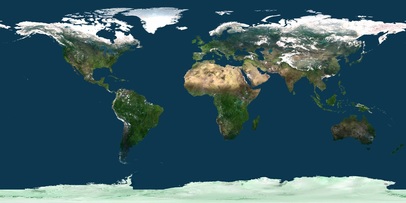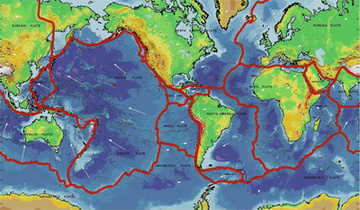Our Solar System
Earth's Surface

Most of the Earth's surface (70%) is covered with water, and the remaining 30% is taken up by the seven continental landmasses. However, underneath the water that fills the oceans, and the dirt and plants that cover the continents, the Earth’s surface layer is made of rock. This outer layer formed a hard, rocky crust as lava at the surface cooled 4.5 billion years ago.
The crust is broken into many large plates that move slowly relative to each other. Mountain ranges form when two plates collide and their edges are forced up. In addition, many othersurface features are the result of the moving plates. The plates move about one inch per year, so millions of years ago the continents and the oceans were in different positions. About 250 million years ago, most of the land was connected together, and over time has separated into seven continents.
The crust is broken into many large plates that move slowly relative to each other. Mountain ranges form when two plates collide and their edges are forced up. In addition, many othersurface features are the result of the moving plates. The plates move about one inch per year, so millions of years ago the continents and the oceans were in different positions. About 250 million years ago, most of the land was connected together, and over time has separated into seven continents.
Earth Layer & Plates

The main force that shapes our planet’s surface over long amounts of time is the movement of Earth's outer layer by the process of plate tectonics.
This picture shows how the rigid outer layer of the Earth, called the lithosphere, is made of plates which fit together like a jigsaw puzzle. These plates are made of rock, but the rock is, in general, lightweight compared with the denser, fluid layer underneath. This allows the plates to "float" on top of the denser material.
Movements deep within the Earth, which carry heat from the hot interior to the cooler surface, cause the plates to move very slowly on the surface, about 2 inches per year. There are several different hypotheses to explain exactly how these motions allow plates to move.
Interesting things happen at the edges of plates. Subduction zones form when plates crash into each other, spreading ridges form when plates pull away from each other, and large faults form when plates slide past each other.
This picture shows how the rigid outer layer of the Earth, called the lithosphere, is made of plates which fit together like a jigsaw puzzle. These plates are made of rock, but the rock is, in general, lightweight compared with the denser, fluid layer underneath. This allows the plates to "float" on top of the denser material.
Movements deep within the Earth, which carry heat from the hot interior to the cooler surface, cause the plates to move very slowly on the surface, about 2 inches per year. There are several different hypotheses to explain exactly how these motions allow plates to move.
Interesting things happen at the edges of plates. Subduction zones form when plates crash into each other, spreading ridges form when plates pull away from each other, and large faults form when plates slide past each other.
